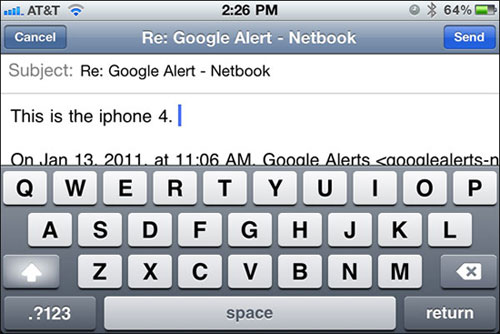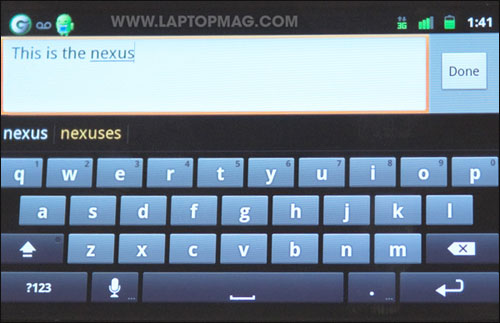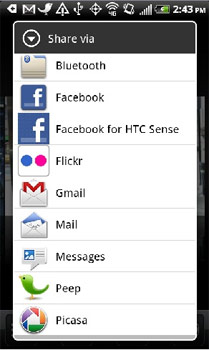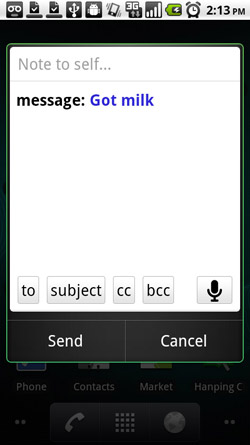Android vs iOS: And the Real Winner is ...
It’s finally a fair fight. An armada of Android devices will face off against the iPhone on Verizon Wireless starting February 10. This battle will take place on the turf of a network that has spent the last two years promoting the heck out of Google’s OS. (Remember the iDont ad campaign?) Sure, AT&T has stocked Android phones for a while, but it hasn’t put much marketing muscle behind them, and the selection up until now has been mediocre compared to Verizon’s. Some say Android has skyrocketed in the U.S. merely because the iPhone was exclusive to a single network for so long. Others say it’s because the software is just plain good--if not better than Apple’s.
We say Android took off initially because people were searching for a decent iPhone alternative. Because the iPhone was locked to AT&T for so long, Google’s OS had the opportunity to evolve into something that should be able to stand its ground. Still, there’s no denying that Android is about to face its toughest fight yet. Here’s how we see the two platforms stacking up.
Editor's Note: We have updated this story since it was originally published.
Interface
The consensus in the industry is that iOS is just more intuitive than Android. That’s mostly true, and the simplicity of the clean, icon-driven interface gives that perception weight. Rarely do you see someone pick up an iPhone for the first time and not know what to do. iOS also gets points for making cut and paste easy and consistent throughout every app. The ability to create folders just by dragging like items on top of one another—and the fact that the folders name themselves based on the type of apps—is further proof that Apple knows how to make smart phones smart.
Android, on the other hand, has a bit of a learning curve. You have to press a button to see all your apps, and that button can vary from device to device. Additionally, cut and paste works differently in different apps, and the various phone manufacturers’ skins that run on top of Android prevent the OS from having a unified look and feel. On the other hand, that variety also has benefits, depending on the device maker. HTC’s Sense is particularly compelling. The biggest advantage for Android in this category is the notification area. You just swipe down to see if you have new e-mails and other alerts. iOS has annoying pop-up alerts instead.
WINNER: iOS. Android has some strengths in the UI department, but the fragmentation of the platform and the steeper learning curve give Apple’s software the edge.
Sign up to receive The Snapshot, a free special dispatch from Laptop Mag, in your inbox.
Keyboard
We don’t know how Apple does it, but its stock touch keyboard remains the golden standard. The layout is easy to use, accurate, and fast.
However, Android devices such as the Epic 4G and the Droid 2 actually come with physical keyboards, an option not available on any iOS product. When it comes to Android’s touch keyboard, the stock Google version has improved with OS 2.3, but it’s only available on a single device thus far. HTC’s virtual Android keyboards are also quite good—especially on Android devices with larger displays—and users can install third-party apps such as Better Keyboard (highly customizable) and Swype (great for typing one-handed). Many Android phones also offer haptic feedback, which mimics the feel of a physical keyboard while you type.
WINNER: Draw. While iOS provides a great touch-typing experience, Android offers a ton of choices, from physical keyboards to specialized input methods such as Swype.
Customization and Widgets
This is an area where Android shines. Although you can certainly move apps around and make folders on the iPhone, the OS doesn’t have anything like Android’s ability to create shortcuts to contacts right on the home screen. There are also dozens of widgets dedicated to different tasks, whether it’s skimming through social networking updates, checking the weather, reading the latest news headlines, or controlling music playback. In a way, the enhanced multitasking in iOS (and Android) has made widgets less necessary over time, but the fact that you can customize the user experience to your taste for at-a-glance information is part of what makes Android so compelling. The weather and stock widgets for iPhone are really just full-screen lite apps.
WINNER: Android. iOS could learn a thing or two from Google’s OS in this department.
Calendar and Contacts
The latest version of the Calendar app for iOS lets you reply to event invites, which is a nice perk. It’s a small touch, but the ability to create a new calendar entry straight from an e-mail is also pretty convenient (thanks to iOS’s smart data detectors). While it’s easy to search and scroll through contacts on an iPhone, Apple hasn’t done much to improve this part of the experience.
Android’s approach to contacts is much more socially connected, especially in the hands of partners such as HTC, Motorola, and Samsung. Most of these Android phones tie into Facebook and Twitter much more deeply. On HTC Sense phones, for instance, your contacts’ Facebook profile photo will show up on their contact card, and you can link to their walls straight from the People app. The Calendar app is nothing special, and we don’t like that you have to press the Menu button and then Edit just to tweak an entry. On iOS the Edit option is always present.
WINNER: Android. In this category—and in general—Google’s OS is more integrated with social networks, an area where Apple needs to catch up.
Multitasking
Many Android fans complain that iOS doesn’t allow true multitasking because apps don’t continue to fully run in the background. We say iPhone users don’t really care; they just want to be able to access recently opened apps without much fuss. Apple does a pretty good job in this department. Double-pressing the home button launches a drawer of four apps, and then you can swipe to see more. You can also close apps from the multitasking menu to save resources, though it requires two additional steps.
With Android, apps don’t just suspend; they continue to run in the background (for better or for worse). Just long press on the Home key to see a grid of the last six apps you used. There’s no swiping to the left or right required, but you can’t see more than those six at once. Plus, you can’t close apps from this menu; you must go under Settings/Manage applications or use a third-party task killer. That’s annoying.
WINNER: Draw. Android scores points for letting you see more apps on one screen and for “full multitasking,” but iOS lets you more easily manage apps—and see more of them—without the need for a dedicated app.
E-mail and Messaging
Gmail is easily one of the best things about Android phones. It’s always up-to-date and it’s a cinch to search your inbox. Plus, Google continually adds new features, such as the addition of a large Send button that’s always present when responding to a message and Priority Inbox (which prioritizes your e-mail based on who you communicate with most). Still, Gmail on Android can be confusing, such as the way it collapses read messages in a given thread, which can make a conversation hard to follow. We’ve also noticed that we’ve had to open an e-mail, back out, and then open it again to see the most recent message in a conversation. POP and Exchange mail work reasonably well in Android, but on most devices (Samsung’s Galaxy tab being a noteworthy exception) those accounts live in a separate e-mail client that doesn’t work as well as Google’s Gmail app.
iOS has made several strides in the last year or so, including the addition of a more intuitive threaded messaging presentation (stacked right on top of one another) and a unified inbox (for those who want it). Where iOS falls flat is push delivery—our Gmail account isn’t always up-to-date—and search. iPhones only store up to 200 messages at a time, so you have to click an option to search for more messages on your server. With Gmail, you just search once, because everything is ready and waiting for you in the cloud.
When it comes to instant messaging, Android has the advantage once more with Google Talk integration. With iOS you need a third-party app, and we haven’t found anything that works as well on Apple’s platform.
iOS currently has a big advantage in the video chat category, thanks to the quality and ease of use of FaceTime. There’s Qik for Android, but the quality is lacking. We have higher hopes for Skype video chat on Android and Google Talk with video chat, but those options aren’t yet available.
WINNER: Android. While the native Gmail app could be more polished, it’s faster and better for search than iOS’ Mail app. And iOS doesn’t have a Google Talk equivalent baked into the platform. Apple’s FaceTime is better than anything in the Android camp, but not enough people are using this feature yet to really move the needle in this round.
App Store and Selection
Quick. Name one awesome, must-have app that came to Android first. Okay, you can stop now. Google deserves a lot of credit for bulking up its Android Market with more compelling apps over the past 18 months. Angry Birds, Bump, Facebook, Pandora. Skype, Twitter; all the important stuff is there, and a lot of the best apps are free.
Nevertheless, iOS still holds a commanding lead both in terms of the number (over 300,000 vs 200,000) and quality of apps. iOS has by far a better collection of games. It’s also easier to pay for apps on iOS, thanks to iTunes. Carrier billing is available for Android, but only on T-Mobile and AT&T. On Verizon Wireless and Sprint you need to use Google Checkout. Because the hardware is essentially constant, most developers prefer the simplicity of iOS, too. One plus for Android, though, is the ability to sideload apps and use alternative app stores.
WINNER: iOS. Better quality, easier purchasing process, and more apps overall.
Web Browsing
iOS and Android are pretty much neck and neck in this category. Both platforms use a webkit-based browser that offers a desktop-like surfing experience. On the iPhone we like that we can tap the top of the screen to display the address bar at any time; only some Android phones have this capability. We also find zooming and scrolling to be smoother on iOS, and pages load slightly faster (over the same Wi-Fi connection). Last but not least, iOS does a better job at presenting open windows, using thumbnails instead of Google’s text-based list.
On Android we like that the address bar lets you search, while search and address are needlessly separated in iOS. We also appreciate the Bookmarks view, which presents thumbnails instead of Apple’s text-based list of sites. It’s debatable as to whether Flash support is a plus on Android, since it can drag down performance. But it’s nice to know that it’s there, especially for those sites that wouldn't otherwise work on iOS. Plus, dual-core phones will speed things up.
However, too many features are buried in Android. For example, to forward a page in Android you need to hit the Menu button, then More, then Share Page. In iOS this option is always present. The problem with the iPhone is that your sharing options are limited. Once we installed a couple of apps on our Nexus S, we could select Facebook, Gmail, and TweetDeck. iOS has just an e-mail option in the browser. That needs to change.
Android has compelling third-party browsers, such as Dolphin HD. It has support for tabs, gestures, and even add-ons. But iOS is closing the gap with great options such as Skyfire (also available for Android) and Atomic Web browser.
WINNER: Android. iOS’ Safari offers a very good browsing experience, but Android supports Flash, so you won’t find any dead-end sites. It also provides more sharing options. Plus, there are plenty of free add-ons for Google’s OS that make surfing sweeter.Maps and GPS
This round is no contest. Not only does Android get new versions of Google Maps first (understandably so), it also includes Google Navigation, which provides free turn-by-turn directions. In our tests, this app has proved to be reliable. The latest Google Maps 5.0 adds 3D buildings and vector-based graphics that makes panning around maps silky smooth.
WINNER: Android. Until Apple does its own thing with Maps, it will always be a step behind Google’s own OS.
Photos and Video
Granted, this category veers more into hardware, but smart phone shoppers want to know which platform does a better job of taking (and sharing) photos. Overall, the iPhone 4’s backside illuminated sensor, combined with a fast shutter speed, offers the best picture quality we’ve seen from any smart phone to date. 720p HD videos are also excellent. A great HDR feature takes three photos in succession and combines the results to achieve excellent images in brighter lighting conditions. With Android devices, quality and speed can vary widely.
However, iOS has limited sharing options. Photos just includes e-mail, though you can use third-party apps. And video has YouTube, MMS, and e-mail. Android has similar options for sharing video, but photo-sharing choices include Facebook, Picasa, Twitter, and more.
WINNER: iOS. Android has more sharing options that are easier to access, but with the iPhone you know you’re getting photos you’ll want to share.
Media
It’s hard to compete with the iTunes ecosystem. iOS devices include easy access to music, TV shows, movies, and books using a single account. Nothing can really compete with having an iPod built into every iPhone. Still, Android has some weapons in its arsenal. Most phones come with Amazon MP3 pre-loaded for music, and there are plenty of third-party apps for accessing music and other content. There’s Pandora, Rhapsody, and Slacker for tunes. Hulu Plus is coming soon, and Netflix is reportedly on the way. Then there’s the Kindle, Barnes & Noble, and other eBook apps. (All of the above are also available for iOS.) The problem is that there’s no one-stop shop for content on Android—at least not yet.
WINNER: iOS. Although you can cobble together a great entertainment experience on Android, it requires more effort.
Software Updates
There’s good news and bad news with both platforms. Android sees updates faster than iOS, getting new features into users’ hands at a quick pace. We also like how you can perform updates over the air. However, that’s assuming the manufacturer and carrier release that update. There are handsets on the market with hardware that can easily support Android 2.2 (nevermind 2.3) but they remain stuck running older software.
With iOS, Apple has the advantage of controlling both the hardware and the software. When it issues an update, you plug in your iPhone and download it, However, when iOS 4 first launched, iPhone 3G owners complained that the update slowed down their devices, a problem which Apple fixed with iOS 4.2. Yes, we wish these updates could be downloaded wirelessly, but if Apple says your device supports the new OS, you can just go get it.
WINNER: iOS. No middleman. No delays that make you want to scream. That’s the way it should be.
Special Features
The fact that 4G-capable Android phones are here now and that Apple likely won’t have one until the summer is a big deal. Speed matters. Google is also first with support for Near Field Communications, which means certain phones will be able to look up data just by tapping a tag or poster. This technology should also enable mobile payments. (Apple is reportedly working on NFC as well.) Android devices also offer the option of a physical keyboard, which Apple does not. Android also has superior voice recognition, whether you’re searching or composing a text.
iOS has some unique and compelling features baked in as well, such as Find My iPhone for tracking down and wiping your device should it be lost or stolen. While some Android phones have this feature, it’s not built into the platform. We mentioned iTunes already, but the convenience of having a single account for apps and all sorts of media purchases cannot be overstated. Game Center in iOS 4 makes it easier to find opponents and compare achievements with friends. Last but not least is AirPlay, which lets you stream media from your iPhone to the Apple TV and AirPlay-compatible speakers with a tap.
WINNER: Android. Google’s OS has done a better job of integrating the latest technologies.
Hardware
Although software is king, hardware design plays a huge role in one's purchasing decision. What Android has in its favor is a wide range of form factors, including sliders and slabs in multiple screen sizes. Some of our favorite designs include the curved and cool Samsung Nexus S with its Super AMOLED display, the HTC Evo 4G and it's massive 4.3-inch screen (and built-in kickstand), and the Samsung Epic 4G for its slide-out keyboard.
Yet with even with all of this variety there's a reason why people covet the iPhone 4. Its supersharp Retina display is second to none in terms of resolution and clarity, and the glass and steel design just feels more luxurious than anything in the Android camp. Despite this sturdiness, the iPhone 4 is thinner and lighter than most Android devices.
WINNER: iOS. Android offers more choices, but the only choice for iOS stands above everything else.
Overall Verdict
| Row 0 - Cell 0 | Android | iOS |
| Interface (10 points) | 7 | 9 |
| Keyboard (5 points) | 4 | 4 |
| Customization and Widgets (5 points) | 5 | 2 |
| Calendar and Contacts (5 points) | 4 | 3 |
| Multitasking (10 points) | 8 | 8 |
| E-mail and Messaging (5 points) | 4 | 3 |
| App Store and Selection (15 points) | 11 | 15 |
| Web Browsing (10 points) | 9 | 7 |
| Maps and GPS (5 points) | 5 | 3 |
| Photos and Video (5 points) | 3 | 4 |
| Media (5 points) | 3 | 5 |
| Software and Updates (5 points) | 3 | 4 |
| Special Features (5 points) | 4 | 3 |
| Hardware (5 points) | 4 | 5 |
| Total Points (out of 100) | 74 | 75 |
If you look at the above scorecard, this face-off was really quite close, with iOS winning six rounds, Android winning six, and the two platforms fighting to a draw in two rounds. Because certain categories in this contest carry more weight, iOS wins by a very narrow margin. iOS is easier to use than any Android device and it has a better selection of apps and premium content--all wrapped up in a one-stop shopping environment. What we love about Android is the ability to truly personalize and customize the user experience. We also like how Android integrates better with social networking services for contacts and sharing content, plus the free turn-by-turn GPS navigation, Gmail and Google Talk, and early 4G support.
Ultimately, you’ll need to decide which of the above categories are most important to you when deciding between an iPhone and Android device. If we’re judging just based on software capabilities and features, the little green robot gets the nod. But when you factor in fit and finish and hardware design, iOS emerges victorious (barely).























